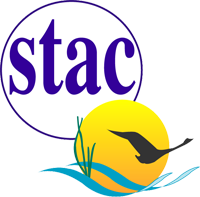By building on the professional and academic contacts and organizational networks of its members, the CRC works collaboratively with various stakeholders in the Chesapeake Bay Program partnership to populate and coordinate scientific reviews of technical reports, policy statements, and activities. Currently, the most significant current review activity of the CRC is coordination of the Chesapeake Bay Program (CBP) Partnership’s Scientific and Technical Advisory Committee (STAC). CRC also works with other organizations for reviews on an ad hoc basis, the most recent of which is an on-going External Independent Peer Review of the Lower Susquehanna River Reservoir System Modeling Enhancements, funded through Exelon and coordinated through the Maryland Department of Natural Resources.
Coordination of STAC Sponsored Reviews
Under long-standing cooperative agreement with the CBP Partnership, the CRC has been working cooperatively with the Partnership to support STAC activities, all of which are designed to promote good science-based management and enhance scientific communication and outreach throughout the Chesapeake Bay watershed and beyond. Thus, these STAC activities is central to furthering defining missions of both the CRC and the CBP Partnership.
STAC comprises 38 scientific and technical experts from across the Chesapeake Bay watershed and provides various important functions of the Chesapeake Bay Program (CBP) Partnership. Through both “proactive” (STAC-originated) and “responsive” (CBPO-originated) reviews, STAC provides independent, unbiased technical guidance to advise the Chesapeake Bay Program’s decision making process.
The Chesapeake Research Consortium (CRC) provides administrative support in the form of salary support for a STAC Coordinator, one or two other STAC support staff, and a portion of time for the CRC Director to serve as STAC Executive Secretary. CRC’s STAC-supported staff thus help ensure close cooperation among and between the various research institutions and management agencies represented in the Bay watershed in various ways, including (1) producing technical reports and position papers, (2) assistance in organizing merit reviews of CBP programs and projects (http://www.chesapeake.org/stac/stac_rev.php), (4) organizing technical workshops (http://www.chesapeake.org/stac/stac_ws.php), (5) facilitating interaction between STAC members and the CBP through four quarterly meetings, and (6) managing the administrative duties of all Federal, Gubernatorial, and at-large members. STAC serves as a liaison between the region’s scientific community and the CBP; proposals for technical reviews or workshops are submitted by the Chesapeake Bay Program or by a STAC member.

